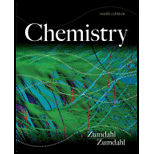
Concept explainers
Interpretation:
The amount of reagents required and range of osmotic pressure has to be calculated.
Concept Introduction:
The mass of the compound is calculated by taking the products of molar mass of the compound to the given mass. The mass of compound can be given by,
Answer to Problem 108AE
To calculate the mass of individual elements
Explanation of Solution
Mass of Sodium =
Mass of Potassium =
Mass of Calcium =
Mass of Chlorine =
Mass of Lactate =
To calculate the mass of individual elements
Molar mass of Sodium lactate =
Molar mass of Lactate =
Molar mass of
Molecular mass of Calcium =
Molar mass of
Molecular weight of Potassium =
Molar mass of
Molecular mass of Sodium=
The average values for each ion are,
The source of Lactate is
Mass of Lactate =
The source of
Mass of
The source of
Mass of
Mass of
Additional amount of Sodium
Mass of Sodium added =
Mass of
Total
Therefore,
The mass of individual elements was calculated using their respective molar mass and molecular weight and the given weight. A typical analytical balance can nearly measure to
Interpretation:
The osmotic pressure at minimum and maximum concentration has to be calculated.
Concept Introduction:
Colligative properties of a substance include the depression in the freezing point, elevation of boiling-point and osmotic pressure. These are dependant only on the number present and not based on the solute particles present in an ideal solution.
The osmotic pressure can be given by the equation,
Answer to Problem 108AE
The range of osmotic pressure is
Explanation of Solution
To calculate the osmotic pressure at minimum and maximum concentration
Record the given info
Mass of Sodium =
Mass of Potassium =
Mass of Calcium =
Mass of Chlorine =
Mass of Lactate =
The masses of individual elements present in the reagent are recorded as shown above.
To calculate the minimum and maximum concentrations of ions
Molar mass of Lactate =
Molecular mass of Calcium =
Molecular weight of Potassium =
Molecular mass of Sodium=
At minimum concentration,
Molarity of Sodium =
Molarity of Potassium =
Molarity of Lactate =
Molarity of Calcium =
Molarity of Chlorine =
The total concentration =
=
At maximum concentration,
Molarity of Sodium =
Molarity of Potassium =
Molarity of Lactate =
Molarity of Calcium =
Molarity of Chlorine =
The total concentration=
=
To calculate the osmotic pressure at minimum and maximum concentration
At minimum concentration,
At maximum concentration,
At minimum concentration, osmotic pressure=
At maximum concentration, osmotic pressure=
The osmotic pressure at minimum and maximum concentrations was calculated using the molarities at minimum and maximum concentration. The osmotic pressure at minimum and maximum concentrations were
Want to see more full solutions like this?
Chapter 11 Solutions
Chemistry
- Specifications for lactated Ringers solution, which is used for intravenous (IV) injections, are as follows to reach 100. mL of solution: 285315 mg Na+ 14.117.3 mg K+ 4.9Q.O mg Ca2+ 368408 mg Cl 231261 mg lactate, C3H5O3 a. Specify the amount of NaCl, KCl, CaCl2 2H2O, and NaC3H5O3 needed to prepare 100. mL lactated Ringers solution. b. What is the range of the osmotic pressure of the solution at 37C, given the preceding specifications?arrow_forwardWhich solute has the greatest effect on the boiling pointof 1.00 kg of water: 50.0 g of strontium chloride (SrCl2) or 150.0 g of carbon tetrachloride (CCl4) ? Justify youranswer.arrow_forwardA solution is made by dissolving 0.455 g of PbBr2 in 100 g of H2O at 50C. Based on the data in Table 8-1, should this solution be characterized as a. saturated or unsaturated b. dilute or concentratedarrow_forward
- The dispersed phase of a certain colloidal dispersion consists of spheres of diameter 1.0 102 nm. (a) What are the volume (V=43r2) and surface area (A = r2) of each sphere? (b) How many spheres are required to give a total volume of 1.0 cm3? What is the total surface area of these spheres in square meters?arrow_forwardSodium chloride (NaCl) is commonly used to melt ice on roads during the winter. Calcium chloride (CaCl2) is sometimes used for this purpose too. Let us compare the effectiveness of equal masses of these two compounds in lowering the freezing point of water, by calculating the freezing point depression of solutions containing 200. g of each salt in 1.00 kg of water. (An advantage of CaCl2 is that it acts more quickly because it is hygroscopic, that is. it absorbs moisture from the air to give a solution and begin the process. A disadvantage is that this compound is more costly.)arrow_forwardYou have two aqueous solutions separated by a semipermeable membrane. One contains 5.85 g of NaCl dissolved in 100. mL of solution, and the other contains 8.88 g of KNO3 dissolved in 100. mL of solution. In which direction will solvent flow: from the NaCl solution to the KNO3 solution, or from KNO3 to NaCl? Explain briefly.arrow_forward

 ChemistryChemistryISBN:9781305957404Author:Steven S. Zumdahl, Susan A. Zumdahl, Donald J. DeCostePublisher:Cengage Learning
ChemistryChemistryISBN:9781305957404Author:Steven S. Zumdahl, Susan A. Zumdahl, Donald J. DeCostePublisher:Cengage Learning Chemistry: An Atoms First ApproachChemistryISBN:9781305079243Author:Steven S. Zumdahl, Susan A. ZumdahlPublisher:Cengage Learning
Chemistry: An Atoms First ApproachChemistryISBN:9781305079243Author:Steven S. Zumdahl, Susan A. ZumdahlPublisher:Cengage Learning Chemistry & Chemical ReactivityChemistryISBN:9781133949640Author:John C. Kotz, Paul M. Treichel, John Townsend, David TreichelPublisher:Cengage Learning
Chemistry & Chemical ReactivityChemistryISBN:9781133949640Author:John C. Kotz, Paul M. Treichel, John Townsend, David TreichelPublisher:Cengage Learning Chemistry & Chemical ReactivityChemistryISBN:9781337399074Author:John C. Kotz, Paul M. Treichel, John Townsend, David TreichelPublisher:Cengage Learning
Chemistry & Chemical ReactivityChemistryISBN:9781337399074Author:John C. Kotz, Paul M. Treichel, John Townsend, David TreichelPublisher:Cengage Learning Chemistry by OpenStax (2015-05-04)ChemistryISBN:9781938168390Author:Klaus Theopold, Richard H Langley, Paul Flowers, William R. Robinson, Mark BlaserPublisher:OpenStax
Chemistry by OpenStax (2015-05-04)ChemistryISBN:9781938168390Author:Klaus Theopold, Richard H Langley, Paul Flowers, William R. Robinson, Mark BlaserPublisher:OpenStax





